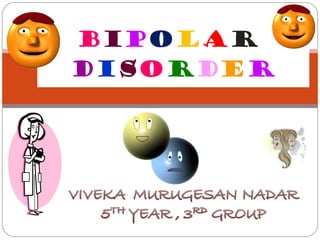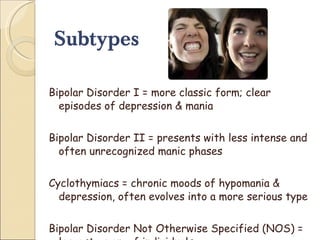Bipolar disorder made by viveka m.
- 1. B I P O L A R D i s o r d e r
- 2. What is Bipolar Disorder? Bipolar Disorder (BD) is a brain disorder that causes unusual shifts in a person's mood, energy, and ability to function People with BD suffer extremes of mania and depression More than 2 million American adults have bipolar disorder Bipolar disorder typically develops in late adolescence or early adulthood It is often hard to diagnosis so people may suffer for years before it is treated BD is a long-term illness that can be controlled, but never cured
- 3. Bipolar Disorder Person alternates between the hopelessness and lethargy of depression and the overexcited state of mania.
- 4. What Causes Bipolar Disorder? BD is a mental illness related to an imbalance of brain chemicals called neurotransmitters The cause of this imbalance is unknown Stress and other mental factors can trigger manic and depressive episodes, but they do not cause BD If parents or siblings have BD, chances of having BD greatly increase.
- 5. Genetics Environment can trigger it and affect the severity of the disorder No single genetic basis Most likely complex genetic disorder One possibility ŌĆ” inherited variation in serotonin transporter gene may play a role.
- 6. Symptoms of Bipolar Disorder This picture shows the range of BD People suffering from BD go through episodes of severe mania all the way down to severe depression
- 7. Manic Episode Symptoms: Inflated self-esteem or grandiosity Decreased need for sleep Pressured speech or more talkative than usual Flight of ideas or racing thoughts Distractibility Psychomotor agitation or increase in goal-directed activity Hedonistic interests
- 8. Hypo manic Episode Similarities with Manic Episode = Same symptoms Differences = Length of time Impairment not as severe
- 9. Major Depressive Episode Symptoms: Depressed mood (in children can be irritable) Diminished interest in activities Significant weight loss or gain Insomnia or hypersonic Psychomotor agitation or retardation Fatigue/loss of energy Feelings of worthlessness/inappropriate guilt Diminished ability to think or concentrate/indecisiveness Suicidal ideation or suicide attempt
- 10. Mixed Episode Both Manic and Major Depressive Episode criteria are met nearly every day for a least a one week period.
- 11. ╠²
- 12. Subtypes Bipolar Disorder I = more classic form; clear episodes of depression & mania Bipolar Disorder II = presents with less intense and often unrecognized manic phases Cyclothymiacs = chronic moods of hypomania & depression, often evolves into a more serious type Bipolar Disorder Not Otherwise Specified (NOS) = largest group of individuals
- 13. ╠²
- 14. Epidemiology Overall affects men and women equally Affects about 1% of adults in the US Usually appears between 15-25 years No difference among racial groups
- 15. Bipolar Brain
- 16. Children vs. Adults (or early vs. late onset ) Irritability Depression Lack of mood reactivity Rejection sensitivity Less evident are the ŌĆ£classicŌĆØ symptoms of mania.
- 17. Co morbidity Attention Deficit Hyperactivity Disorder (ADHD) Between 60-80%
- 18. Criteria Comparison Bipolar Disorder (mania) More talkative than usual, or pressure to keep talking Distractibility Increase in goal directed activity or psychomotor agitation ADHD Often talks excessively Is often easily distracted by extraneous stimuli Is often ŌĆ£on the goŌĆØ or often acts as if ŌĆ£driven by a motorŌĆØ Differentiation= elated mood, grandiosity, decreased need for sleep, hyper sexuality, and irritable mood.
- 19. Co morbidity (cont.) Oppositional Defiant Disorder (ODD) & Conduct Disorder (CD) 70-75% Substance Abuse 40-50% Anxiety Disorders 35-40%
- 20. Suicidal Behaviors Prevalence of suicide attempts 40-45% Age of first attempt Multiple attempts Severity of attempts Suicidal ideation
- 21. Suicide
- 22. Cognitive Deficits Executive Functions Attention Memory Sensory-Motor Integration Nonverbal Problem-Solving Academic Deficits Mathematics
- 23. Psychosocial Deficits Relationships Peers Family members Recognition and Regulation of Emotion Social Problem-Solving Self-Esteem Impulse Control
- 24. Bipolar Disorder in Children About 1 million American children and teenagers struggle with bipolar disorder Most are misdiagnosed, undiagnosed or untreated Researchers believe many children with bipolar disorder are misdiagnosed with ADHD, because hyperactivity is a symptom of both. It is imperative that children be diagnosed early on in childhood. Early treatment may prevent a worsening course of the illness later on in life.
- 26. Psychopharmacological DEPRESSION Mood Stabilizers Lamictal Anti-Obsessional Paxil Anti-Depressant Wellbutrin Atypical Antipsychotics Zyprexa MANIA Mood Stabilizers Lithium, Depakote, Depacon, Tegretol Atypical Antipsychotics Zyprexa, Seroquel, Risperdal, Geodon, Abilify Anti-Anxiety Benzodiazepines Klonopin, Ativan
- 27. ╠²
- 28. Therapy Psycho education Family Interventions Cognitive-Behavioral Therapy RAINBOW Program Interpersonal and Social Rhythm Therapy Schema-focused Therapy
- 29. Other Considerations Educating staff Communication Hospitalization
- 30. Future? Researchers believe they are coming closer to finding a genetic link and mechanism of the disorder. This could lead to better drugs that would act specifically for bipolar disorder.
- 31. ╠²
- 32. WEBSITES: Bipolar disorder- MayoClinic.com www.mayoclinic.com/health/bipolar-disorder/DS00356 The Child and Adolescent Bipolar Foundation www.bpkids.org Depression and Bipolar Support Alliance www.dbsalliance.org Parents of Bipolar Children www.bpparent.org www.webmd.com/bipolar-disorder/default.htm
- 33. ╠²
Editor's Notes
- A mixed episode includes both manic and major depressive episodes every day for at least one week. The criteria for duration of each episode obviously does not need to be met (e.g., manic symptoms for a week).
































